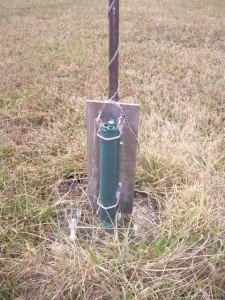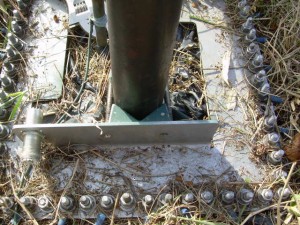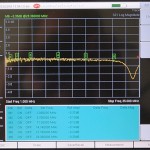About two years ago I received a DX Engineering Radial Plate for Christmas. Nice gift for a ham eh?
It has been serving as the focus of twenty-eight 33′ radials and a 16.6′ vertical antenna for over a year with great results. A QSO, a 20 meter phone QSO, with a station in Australia was the highlight. Okay he had a stack of four 20 meter beams phased and pointing straight at me, but it still makes me like my dirt based 20 meter vertical.
The old antenna has a custom home-brew mount which required an insulated ground pipe to work correctly. This pipe was a piece of PVC about 1.5 inches in diameter.
After a year of service, here is what the antenna looks like…
Don’t laugh… it works weeds and all.
This antenna works on 20, 17 and 15 meters, but is rather pointless for 10, 40, etc. for obvious reasons. So recently I decided to change the vertical to a new 43 foot, tuner required, model to gain access to other bands with as little change as possible. As this antenna desires to be attached to a 2 inch OD pipe, I dutifully purchased one at the local home center and replaced the smaller PVC pipe of the former antenna.
Things were going splendidly until I tried to clamp the radial plate to the new two inch OD pipe…
Hmmm, the holes in the DX Engineering Radial plate would not accommodate clamps this large even though the instructions that came with the antenna clearly suggest it would.
Could it be the current Radial Plate was different than the one two years ago?
An email to DX Engineering promptly confirmed my suspicions. They changed the design of the plate to wider slots to accommodate larger clamps in addition to the originally supported narrow clamps.
They did this without an obvious change to the model name to emphasize the difference.
They suggested the hardened stainless steel would most certainly harm all, but the toughest drill bits. My choices are to take it to a machine shop to enlarge the holes or just purchase a new one. I have access to a machine shop, but have decided to just purchase another one and save the older unit for other projects.
DX Engineering perhaps could have done something different here. On the other hand, at least they are continuing the development of their product lines. A little lesson in Configuration Management would go a long way to helping them clearly name new revisions of products something different.
Oh well. I remain a big fan of DX Engineering if nothing else for the superior materials used. The old radial plate has been sitting in the dirt for over a year and has zero corrosion issues. Bravo.




DX Engineering products are made without compromise. DX Engineering always uses superior materials and expert engineering